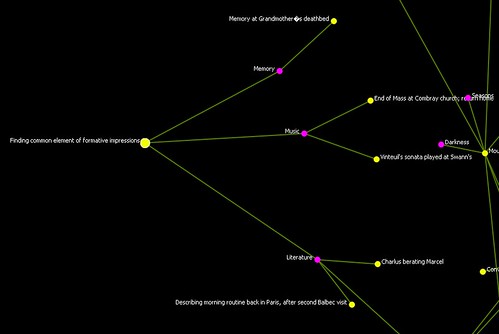I thought I would do some closer "distant-reading" of the Recherche. When using ORA to look at a metanetwork, the visualization can be manipulated in real time to highlight the links among nodes and their related concepts or passages. What this means for the study of Proust is that we can think of the novel (and the novel genre) as a network of nodes consisting of concepts, characters, narrative elements, and any other unit of meaning that might enhance exploration of its text.
For instance, isolating the network constellated around the note “Finding common element of formative impressions” shows that the narrator's activity of reflecting upon his formative impressions is primarily connected to the associations of Memory, Music, and Literature.
The Memory association in turn connects with “Memory at Grandmother's deathbed”; Music connects with “End of Mass at Combray church, return home” and “Vinteul's sonata played at Swann's”; and Literature connects with “Charlus berating Marcel,” “Epiphany at Guermantes' Party,” and “Describing morning routine back in Paris, after second Balbec visit.” When the nodes above are moused over to show the passages they represent, we see that most of them, from various sequences involving musical performance or literary discussion from all over the novel, refer to the twin steeples at Martinville that formed the subject of the narrator's first piece of writing as a youth (I.253-257). Thus, the steeples form an orientation point for that part of the narrator's writerly vocation that pertains to analysis of impressions, filtered primarily through memories of music and literature. These connections are not apparent by searching the database at the Ecclesiastical Proust Archive because it does not provide the simultaneous view of layered networks afforded by ORA. It seems on the surface, then, that this particular network within the Recherche forms a theory of impressionism based on the structural commonalities between music and literature.
The network for the Time association similarly connects various types of recollection to provide insight into the narrator's artistic development.
We find Time at the center, ringed by “Contemplation sparked by conversation with M. de Cambremer, at Guermantes party,” “Imagining Florence and Venice (before visit),” “Contemplating experience of Vinteuil's sonata while jealous of Mlle Vinteuil and Albertine,” “Contemplating women and past,” “Observations at Guermantes party,” and “First visit to Balbec.” The last in turn connects with Narthex and Carqueville. In other words, the primary function of Time as a backwards-looking concept is associated with jealousy over women, while the forward-looking passages imagine the reddish domes of Florence and the frescos of Venice. This suggests a deepening of the structure that became apparent in the database searches, where the thought of meeting a future lover in early passages, though not explicitly concerned with the nature of time, took place on the porch of a gothic cathedral. These nodes presented by ORA show that the church passages that consciously deal with the nature of time happen after the narrator as had experience being in love with women. And correspondingly, the architectural element of this ring is the narthex, which is the entrance area just indoors or on the threshold to the porch. The narthex was not considered part of the church proper, but was placed close enough so that those not worthy of entry, such as the unbaptized or unconfessed, could still receive instruction from services. Hence, the experience of love has brought the narrator past the porch but, because he is lost through jealousy, he still remains an outsider.
The Truth network presents a very clear view of the novel's main thematic chains and character developments.
With Truth at the center of the middle network, the first ring comprises “Riding in Dr. Percepied's carriage” (the moment at which he observed in motion the twin steeples of Martinville), “Reflections on getting the truth about Albertine from Andrée” (in which he had final confirmation of his lack of knowledge about Albertine's lesbianism, the root of his obsessive jealousy), “Reading Bergotte” (the writer who most influenced his literary sensibility, and who figures so prominently in his appreciation for churches), and “Reflection on Charlus' perversion” (the unmasking of homosexuality as a major recurring element of the novel's concern with epistemology). What we also see in the picture above are two micro networks that are not directly connected, yet were placed close to the Truth network because of their conceptual affinity. If we take all three networks into consideration, the second ring around the Truth association comprises Motion, Laws, the Archaic, Beauty, and Knowledge, which further connect with three passages about household habits and the Great War. Taken together, Truth in Proust's novel can ultimately be understood as a rather stable essence based on the epistemic laws of motion and observation, as well as the aesthetic laws of beauty as evident in old objects. These, too, are a function of Time. While this visualization might not provide much insight that is new in Proust studies, the interface at least allows the reader instantly to access the passages that contribute to a given part of the network.
